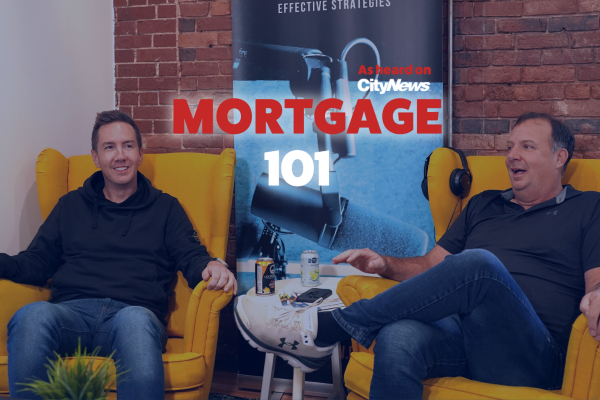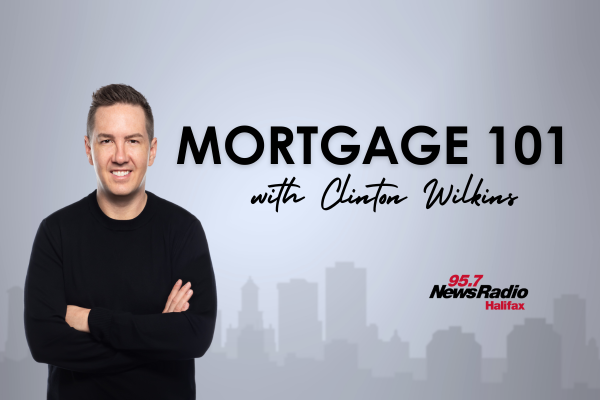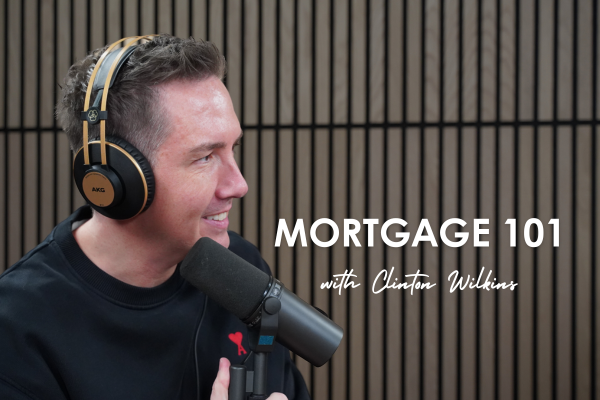Sandi Burns, Chief Credit Officer at Manulife Bank, joins Todd and Clinton to discuss the increasing prevalence of mortgage fraud, the importance of regulatory compliance and evolving landscape of mortgage fraud.

Mortgage 101 – Fall for Real Estate: Down Payments & Amortizations | October 2nd, 2023
In this edition of Mortgage 101, Clinton and Todd are talking rates, down payments and amortizations. The guys discuss why fall is a great real estate season, where the rates are at now, how things have changed over the years, borrowing down payments and amortization options.
Please note that the below content is pre-recorded and may not always reflect the most current information or developments.
Todd Veinotte 00:00
Oh hopefully you are dry and safe and your home is good. And Hurricane Lee, well it was post-tropical by the time it hit this region, or whatever impact it is, hopefully, you guys are safe, right?
Clinton Wilkins 00:16
And I’m sure we’ll have lots of listeners this weekend because I’m sure people will be tuned in and listening to all of the news. So if anybody has any feedback for us, feel free to reach out whether that’s an email or you send us a message on social media. You know, we’ve been getting lots of messages lately. And some people thanking us just for some of the advice. We were talking about insurance and we had a customer write us, or I guess a listener write us. I always say customers because that’s my business. But a listener wrote us to say, you know, thank you I talked to my insurance company, I’ve increased my insurance. So that’s great feedback. And we love when we get that kind of feedback. And if there’s something you specifically want us to talk about, you can certainly send us a little note.
The fall real estate market
Todd Veinotte 00:59
Why is fall traditionally, fall and spring, those are the two big markets eh?
Clinton Wilkins 01:03
Yeah, I think spring is definitely probably traditionally the biggest market. Some people think like, summer is dead. Winter is dead. But fall, I honestly is one of my favorite real estate markets. And I’m going to tell you why. Here’s my little tip and trick. So you know, people who listen to the show, you’re gonna have a leg up on everybody else. People who have not sold their home from the spring going into the fall. And if they really want to sell their home, typically, they’re more motivated to sell. Because they don’t want to hold this piece of real estate through the winter. They don’t want to pay for the heat. They don’t want to pay for the maintenance. They don’t want to pay the mortgage, they don’t want to pay the property taxes. So I think vendors sometimes are a little bit more motivated when the fall happens. And the great time to shop for a new home in the fall means you’ll probably get into this home before that holiday season.
Todd Veinotte 01:56
Yeah a lot of people will be simply I want to get moved before Christmas. It could be as simple as that.
Clinton Wilkins 02:01
It could be as simple as that. And we are right in the zone because when we do a mortgage approval, we are approving mortgages up to now, January 2024.
The current state of mortgage rates
Todd Veinotte 02:09
What are some of the rates you’re guaranteeing right now?
Clinton Wilkins 02:13
Rates are all over the place, Todd. If you’re doing a high ratio purchase, if it’s a fixed rate, I know we talked about, you know, five year fixed, and we’ll talk about you know what rate you shouldn’t take later in the show. But a five year fixed rate now is somewhere around like 5.5%.
Todd Veinotte 02:25
Yeah, yeah. And listen, that obviously seems high. And it is high compared relatively speaking compared to what it was. But when you look at what happened with inflation in the, of course in the 80s, and what the Bank of Canada had to do. I mean, interest rates were up 18, 20% in some cases at that point, right?
Clinton Wilkins 02:41
Correct.
Todd Veinotte 02:42
So and I realize that the volumes of money borrowed was much less at that time, however, people’s incomes were much less at that time. So it’s all probably relative. It’s all relative time.
Clinton Wilkins 02:55
People that went through that type of economic situation and that inflation. They were in certainly much more dire situations than we are in today. We may feel that, hey, the sky is falling, because our interest rates are 5% and 6%. But, you know, overall, it’s actually not bad. And that is the median mark on where rates normally aren’t. Yeah. So they say the medium mark is somewhere around that, like 5% range. Like if we, if we go back in history,
The banks and elevated rates
Todd Veinotte 03:28
Yeah. Okay so let me ask you this, with these rates, elevated interest rates, it’s good for the banks, obviously. Right? Or the lenders?
Clinton Wilkins 03:37
Yes and no.
Todd Veinotte 03:38
If you’re making more money on interest that –
Clinton Wilkins 03:40
I think they’re making more money, but their cost of funds, is that much more.
Todd Veinotte 03:43
What do you mean?
Clinton Wilkins 03:44
Because they gotta borrow money. And if you have money in the bank, guess what, you’re getting more return on your investment that you normally do. So yes. You know, obviously, having a higher cost of interest, but the cost of funds being higher, they’re all working on margin Todd. They’re all working on margin. And it might seem okay, the banks making all this money because the interest rates are higher, but their cost of funds are higher, too. Relative, maybe as well. I think the banks make a lot of money, no matter which bank it is. They will make a lot a lot of money.
Todd Veinotte 04:18
They’re like you said the casino right?
Clinton Wilkins 04:19
They’re like the casino. The banks never lose. And the federal government is actually putting in some legislation that’s going to be impacting the banks, that they have to have more funds on deposit to lend out that much, which is going to increase their cost of funds even more, which might squeeze those mortgage rates even more.
Todd Veinotte 04:36
When’s that gonna happen?
Policy changes on mortgages over the years
Clinton Wilkins 04:38
If there’s legislation that is changing. You know, there’s some that’s going to probably be changing here, obviously, like in the fall before the end of the year, but the federal government is always looking through the Office of the Superintendent of Finance. He’s always looking at making changes that are going to you know protect Canadians really from themselves and protect the banks from borrowers. So they’re always always looking at different ways to like tweak and change things. And I’ve remember and I’ve been doing this for 17 years, there have been multiple policy changes that have impacted multi mortgage lending. In one year. Multiple.
Todd Veinotte 04:36
Can you give me some examples?
Clinton Wilkins 04:47
We used to do refinances up to 95%
Todd Veinotte 05:03
What’s it now?
Clinton Wilkins 05:04
80%. So you used to be able to get a high ratio refinance from a lender, now it’s all conventional. We used to have I amortizations, up to 40 years.
Todd Veinotte 05:24
40. Wow, I didn’t know it’s 40.
Clinton Wilkins 05:27
Yeah, and you sell to buy a home with zero down. Zero down 40 yearr amortizations. If you had a heartbeat we’re giving you a mortgage.
Todd Veinotte 05:47
And you can see how that could be problematic when it comes to –
Clinton Wilkins 05:51
100%. I can see how that’s problematic.
Todd Veinotte 05:52
Because the risk factors and risk tolerance here, right?
Clinton Wilkins 05:56
You know, people are getting homes with literally like no skin in the game.
Can you borrow a down payment?
Todd Veinotte 06:00
Right. Right. Can you still borrow because you hear other commercials, other lenders, other than yourself, who we shall not mention, say that you can borrow the down payment from them. Can you do that?
Clinton Wilkins 06:12
Yes, we do borrow down all the time, Todd. So Nova Scotia has a borrow down payment program, which is amazing. They allow a household income over $100,000 to buy a home, I think it’s 140 or 150 –
Todd Veinotte 06:27
So that’s no skin in the game, then if you’re coming in –
Clinton Wilkins 06:30
Well you still have to have the money for the closing costs, and you need to be approved for the mortgage and you need to be approved for the Nova Scotia down payment assistance program. And you have to pay the loan back in over 10 years. It’s interest free.
Todd Veinotte 06:40
Oh, is that right?
Clinton Wilkins 06:41
They give you 10 years to pay it back.
Todd Veinotte 06:42
So that loan is not rolled into the mortgage.
Clinton Wilkins 06:44
Separate payment.
Todd Veinotte 06:45
Interesting, interesting I didn’t know that.
Clinton Wilkins 06:47
So it’s basically a second mortgage. And you pay a higher insurance cost to the Canadian Mortgage Housing Corporation, Sagen or Canada Guarantee because technically, it’s a borrowed down payment. So you can do that. The other type of borrowed down payment we do is, and if you’re actually borrowing it from like a line of credit or a loan or credit card or something like that, you can do a borrowed down payment. And it’s the same insurance costs if you do the Nova Scotia down payment assistance program, or if you do the borrow down.
Todd Veinotte 07:11
Okay, so what’s the interest on the down payment? Do you know? Would it vary? I suppose it would.
Clinton Wilkins 07:16
Well, depends. If you’re borrowing yourself, it would be whatever the credit facility is or from the Nova Scotia down payment assistance program. It is an ostrich egg. Zero. Ostrich.
Todd Veinotte 07:25
Alright, so obviously, the best case scenario is you’re walking in there and you get 20% of your own money to lay down on the table.
Clinton Wilkins 07:32
Yeah if you do 20% down, you can do an extended amortization, like you can do 30 years. Plus, you can have access to like alternative lending sources, like if you need to do stated income deal. Or if you’ve had any credit issues or stuff like that, if you do 20% down, it opens up a lot more doors. And you don’t need the concurrence from the Canadian Mortgage Housing Corporation, Sagen or Canada Guarantee. There’s three insurers in Canada.
Down payments and amortizations
Todd Veinotte 07:54
How often are you seeing 20%?
Clinton Wilkins 07:57
The bulk of the transactions we’re doing are currently conventional with 20% down or more. The bulk.
Todd Veinotte 08:04
I’ve never paid 20 I’ve always paid 5, obviously, because I’ve not had enough money to pay 20 over the years. But –
Clinton Wilkins 08:08
But you know what? That’s been okay. It’s worked out for you. You’ve also bought real estate improved it and then it’s been more money. So everybody’s situation is different. But I think that brings up a really good point, Todd. You’ve owned multiple homes but you’ve also bought homes even recently, and put only 5% down. So that’s a misconception. People think you can only put down 5% on your first home. If it’s owner occupied, you can put 5% down forever.
Todd Veinotte 08:35
Forever, yeah. If it’s not owner occupied then you need 20%.
Clinton Wilkins 08:39
Can you go 5 year, 30 year? No.
Clinton Wilkins 08:39
20% yeah. Or I mean, if it’s a rental, you need 20% down. But if it’s not owner occupied, like, let’s say it’s a second home, or you’re buying a home for your kid or a family member to live in, you can still get a high ratio mortgage.
Clinton Wilkins 08:42
No. 25 years. On a high ratio 25 years is the max.
Todd Veinotte 08:57
Right, right. So obviously, if people want to get into the larger home or whatever, and they have the 20% and they amortize it out over 30 years. That’s the ideal scenario for somebody if their income might not be quite what it, like to get into something that they want. That’s an option, right?
Clinton Wilkins 09:16
That’s basically what I did for myself. I did a 30 year amortization. You know what, for me, I would always try to do a 25 year because the 25 year has a lower interest rate. The reason I did a 30 for myself, and I’m going to be completely honest, I’ll talk about my own personal finances. The reason I did 30 was because I’m self-employed. And who knows, I didn’t know what the future was going to bring. But as soon as I funded that mortgage, I did a payment increase. And I brought it up to 20 years, made payments, made payments, made payments, had it down to about 18 years. And then obviously with the interest rates going up. The amortization is longer now. But I did have the intention on paying it down faster, and I pay down a bulk of the principle in the last couple of years that I’ve had the mortgage. I paid down thousands and thousands of dollars.
Todd Veinotte 10:09
Accelerated bi-weekly payments that makes a difference too right?
Clinton Wilkins 10:12
Accelerated certainly makes a difference, if you’re paid bi-weekly do a bi-weekly payment, whether it’s accelerated or regular. I always recommend people matching up their mortgage payment with their payroll. It’s painless. I do weekly because I pay myself weekly. No pain. My pay goes in my account Monday. Monday morning. And guess what, Monday night my mortgage payment comes out.
Todd Veinotte 10:34
Alright, so everybody’s waiting to know the rate not to take, we’re gonna get to that next.
Clinton Wilkins 10:38
The rate not to take. Stay tuned.
Todd Veinotte 10:40
Mortgage 101 your guide to homeownership.
Clinton Wilkins 10:51
If you’ve liked what you’ve heard, and you want to learn more, feel free to visit us online at teamclinton.ca

